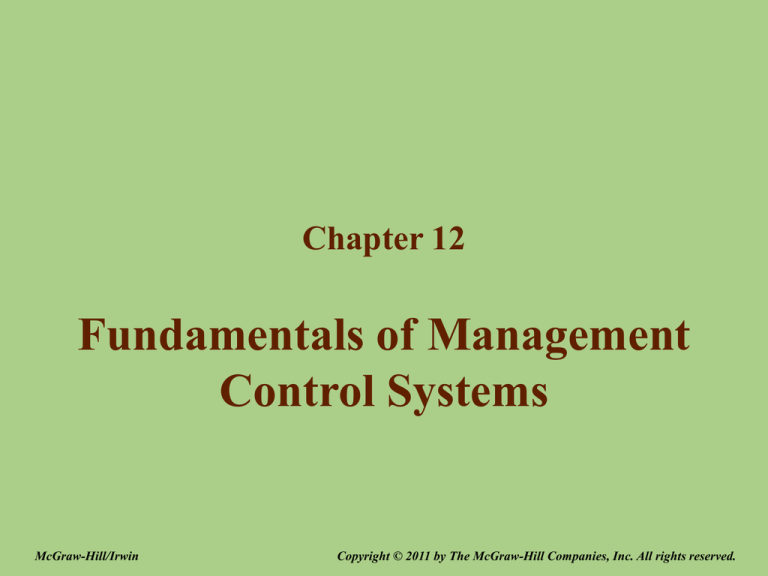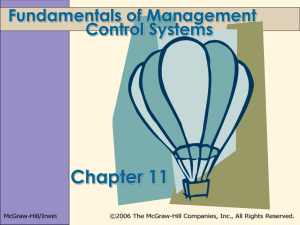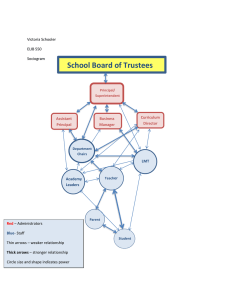
Chapter 12
Fundamentals of Management
Control Systems
McGraw-Hill/Irwin
Copyright © 2011 by The McGraw-Hill Companies, Inc. All rights reserved.
Alignment of Managerial and
Organizational Interests
L.O. 1 Explain the role of a management control system.
• A management control system is designed
to help managers make decisions that will
increase the organization’s performance.
12 - 2
Decentralized Organizations
L.O. 2 Identify the advantages and disadvantages of decentralization.
• Decentralization is the delegation to
subordinates of authority to make
decisions in the organization’s name.
12 - 3
LO2
Advantages of Decentralization
• Better use of local knowledge
• Faster response
• Wiser use of top management’s time
• Reduction of problems to more manageable size
• Training, evaluation, and motivation of local managers
12 - 4
LO2
Disadvantages of Decentralization
• Dysfunctional decision making:
Local managers can make decisions in their interest,
which can differ from those of the organization.
• Duplication of administration:
Local managers make the same types of decisions
made at headquarters.
12 - 5
Management Control System
L.O. 3 Describe and explain the basic framework
for management control systems.
• It is a system designed to influence subordinates
to act in the organization’s interest.
• Principals (owners) use this system to influence
agents’ (managers’) behavior.
12 - 6
LO3
Elements of a Management
Control System
• Delegated decision authority
• Performance evaluation and measurement systems
• Compensation and reward systems
12 - 7
Responsibility Accounting
L.O. 4 Explain the relation between organization
structure and responsibility centers.
• Responsibility accounting reports revenues
and costs at the level within the organization
having the related responsibility.
Responsibility
Cost
centers
Revenue
centers
Profit
centers
Investment
centers
12 - 8
Evaluating Performance
L.O. 5 Understand how managers evaluate performance.
• Controllability concept:
Managers should be held responsible
for costs or profits over which they have
decision-making authority.
• Relative performance evaluation (RPE):
Compares divisional performance with that
of peer group divisions
12 - 9
Corporate Cost Allocation
L.O. 6 Analyze the effect of dual- versus single-rate allocation systems.
Global Electronics
Latin America Division
Income for the Year ($000)
Actual
Target
Revenue
$70,000 $70,000
(Percentage of corporate revenue)
16%
14%
Direct division costs
51,800
51,800
Allocated corporate overhead*
4,800
3,500
Operating profit
$13,400 $14,700
* Global Electronics allocates corporate overhead based on relative revenue.
Corporate overhead was $25 million.
12 - 10
LO6
Corporate Cost Allocation
Global Electronics
Latin America Division
Income for the Year ($000)
Revenue
Direct division costs
Actual
$70,000
51,800
Target
$70,000
51,800
My revenue
and costs
were on target.
12 - 11
LO6
Corporate Cost Allocation
Global Electronics
Latin America Division
Income for the Year ($000)
Actual
Target
Revenue
$ 70,000 $ 70,000
(Percentage of corporate revenue)
16%
14%
Corporate revenue
$437,500a $500,000b
a
$70,000 ÷ 16%
b $70,000 ÷ 14%
I'm not
responsible for
corporate
revenue.
12 - 12
LO6
Corporate Cost Allocation
Global Electronics
Latin America Division
Income for the Year ($000)
Actual
Target
Allocated corporate overhead
$ 4,800 $ 3,500
(Percentage of corporate revenue)
16%
14%
Corporate costs
$30,000a $25,000b
a
$4,800 ÷ 16%
b $3,500 ÷ 14%
I'm not
responsible for
corporate
costs.
12 - 13
LO6
Corporate Cost Allocation
Cost
Cost
• Dual rate method:
This is a cost allocation method that separates a
common cost into fixed and variable components
and then allocates each component using a
different allocation base.
Activity Level
Activity Level
12 - 14
Performance Evaluation
Systems Incentives
L.O. 7 Understand the potential link between incentives
and illegal or unethical behavior.
• Fundamental questions regarding a performance
measurement system:
• Does the measure reflect the results of those actions
that improve the organization’s performance?
• What actions might managers be taking that improve
reported performance but are actually detrimental to
organizational performance?
12 - 15
Internal Controls
L.O. 8 Understand how internal controls can help protect assets.
• Internal control is a process designed to provide
reasonable assurance that an organization will
achieve its objectives in the following categories:
• Effectiveness and efficiency of operations
• Reliability of financial reporting
• Compliance with applicable laws and regulations
12 - 16
End of Chapter 12
McGraw-Hill/Irwin
Copyright © 2011 by The McGraw-Hill Companies, Inc. All rights reserved.








